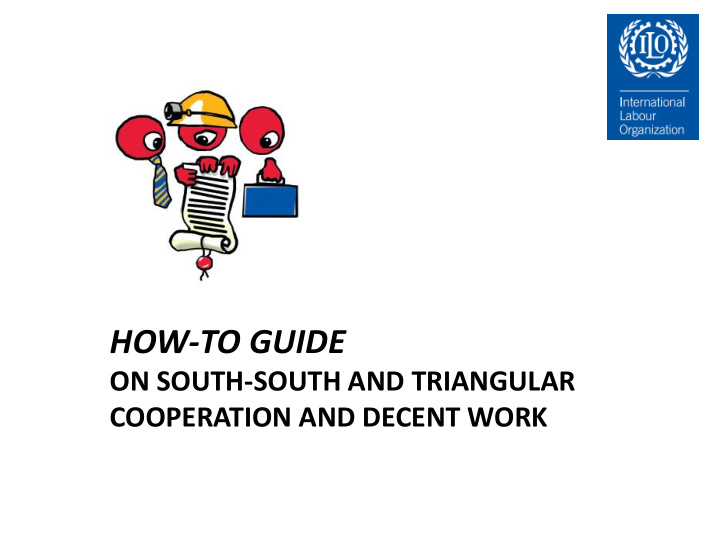



HOW-TO GUIDE ON SOUTH-SOUTH AND TRIANGULAR COOPERATION AND DECENT WORK
Contents Introduction South-South and triangular cooperation: some definitions South-South and triangular cooperation Principles of South-South and triangular cooperation according to the ILO Processs Actors involved Modalities and examples South-South and triangular cooperation step-by-step South-South and triangular cooperation step-by-step (Table 1) The role of the ILO ILO support for South-South and triangular cooperation (Table 2) Do’s and Don’ts of South -South and triangular cooperation (Table 3) How to identify good practices in South-South and triangular cooperation Useful resources
South-South and triangular cooperation: some definitions Nairobi outcome document of the High-level United Nations Conference on South-South Cooperation Framework of operational guidelines on United Nations support to South- South and triangular cooperation South – South and triangular cooperation: The way forward
The Nairobi outcome document identifies the following principles of South-South and triangular cooperation: • Respect for national sovereignty and ownership • Partnership among equals • Non-conditionality • Non-interference in domestic affairs • Mutual benefit • Mutual accountability and transparency • Development effectiveness • Coordination of evidence-and results-based initiatives • Multi-stakeholder approach..
Process • The promotion and sharing of good practices between constituents is part of the commitment of the ILO. • South-South and triangular cooperation should also be regarded as one of the means that the ILO and its constituents can use to deliver Decent Work Country Programmes
Actors involved • Under the ILO’s tripartite structure, governments, workers’ and employers’ organisations are formally part of the implementation process • Regional and international organizations • Bilateral agencies • Academic institutions • National institutions and networks
Modalities Capacity-development activities Sharing experiences and good practices Building partnerships Creating and strengthening networks and platforms
South-South and triangular cooperation step-by-step
The role of the ILO The ILO brings tripartite constituents together and acts as a facilitator to set cooperation strategies The ILO documents and disseminates a wide range of knowledge (compilation of good practices, knowledge exchange platforms and forums) The ILO forges inclusive partnerships and sets strategic alliances with the purpose of transferring expertise The ILO follows-up and reports on major inter-governmental decisions regarding South-South and triangular cooperation
Do’s and Dont’s
Do’s and Dont’s
How to identify good practices in South-South and triangular cooperation • “Horizontal” dimension of cooperation • “Triangular” dimension of cooperation • Innovative • Adaptability/Replicability • Sustainability
Recommend
More recommend